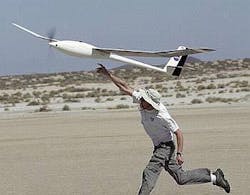Attention small UAV designers: DHS wants you for a homeland security surveillance flyoff
WASHINGTON, 26 Sept. 2012. Officials of the U.S. Department of Homeland Security (DHS) in Washington are asking industry to participate in a fly-off evaluation of small unmanned aerial vehicles (UAVs) and integrated UAV sensor payloads for potential use by local civil authorities maritime border and maritime security, law enforcement, search and rescue, fire, and hazardous material spill response.
The DHS Science and Technology (S&T) directorate issued a request for information (DHS13-01) Monday for the Robotic Aircraft for Public Safety (RAPS) program, which seeks to conduct flight testing and evaluation of airborne sensors and small UAVs for potential transfer to its customers.
The RAPS project will invite small UAV vendors to Fort Sill, Okla., to evaluate each system under a wide variety of simulated real-world operational scenarios in law enforcement, search and rescue, fire and hazardous material spill response.
DHS officials are asking small UAV vendors of rotary- and fixed-wing design that weigh less than 25 pounds each to provide technically mature, flight-proven UAVs and integrated sensors for the evaluation.
RAPS program officials define small rotary-wing UAVs as having endurance of 30 minutes to one hour, range of one to three miles, speed of 10 to 30 miles per hour, and. altitude of 400 to 1,000 feet above ground level.
Fixed-wing small UAVs have endurance of 30 minutes to two hours, range of three to six miles, speed of 20 to 40 miles per hour, and altitude of 400 to 1,000 feet above ground level. The service ceiling of both kinds of UAVs should be 6,000 to 10,000 feet above sea level.
DHS officials caution that this request for information only is for market research, and is not a formal solicitation.
Companies interested should submit white papers no later than 31 Oct. 2012 describing the capabilities, maturity, flight experience, and safety performance of each small UAV. If chosen, each company will receive a test plan and will be assigned five consecutive flight days for demonstrations.
Submit white papers, questions, or concerns by e-mail to [email protected]. More information is online at https://www.fbo.gov/spg/DHS/OCPO/DHS-OCPO/DHS13-01/listing.html
Follow Military & Aerospace Electronics and Avionics Intelligence news updates on Twitter
